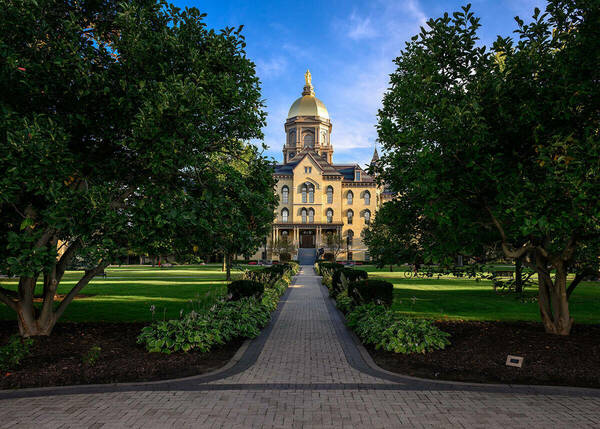Notre Dame Professor Jankó and collaborators receive Army grant for Quantum Computing Research
Boldizsár Jankó, physics professor at the University of Notre Dame, and collaborators have received a grant from the Army Research Office, a directorate of the U.S. Army Combat Capabilities Development Command Research Office, for research on vortex manipulation in superconductors — a process that will be necessary to advance quantum computing technology in the future.
Superconducting circuits can conduct electricity without any resistance in cold temperatures. However, they can contain tiny magnetic whirlpools, called vortices, that are destructive, much like tornadoes.
"When these superconducting vortices — these tiny filaments or tornadoes — get stuck in the device, just a few of them will basically render the device useless,” said Jankó, who has been studying vortices throughout his career. “The operation margins shift, and the device just doesn't work well."
The grant will span four years and is divided between Jankó, who is the principal investigator in charge of the project, and six co-principal investigators from Notre Dame, Argonne National Laboratory in Lemont, Illinois; Northern Illinois University, in DeKalb, Illinois; the University of Bath in Bath, England; and the University of Antwerp in Antwerp, Belgium.
The project calls for the addition of three postdoctoral scholars at Notre Dame. Two will be theoretical physicists, and one will be an experimentalist who will be based at Argonne.
Using computer simulations and experiments, Jankó and his team will design and test new types of circuits with specific patterns that can control and remove the tiny magnetic whirlpools. The work will involve adding new device features that will actively remove the vortices without the costly and time consuming thermal cycling. Their work should lead to significant improvements in the circuits that will increase their applications.
Using microscopy is key as the researchers map the surface of samples. The team at the University of Bath, led by physics professor Simon Bending, will use a novel form of scanning probe imaging called scanning Hall probe microscopy.
“By mapping the surface of samples with a nanoscale Hall sensor at cryogenic temperatures we can image vortices and vortex patterns and follow their dynamics under various driving currents and driving fields,” Bending said. “In this way we plan to visualize experimentally the effects that the theoretical collaborating groups will be predicting and simulating, allowing new generations of more effective chip designs to be developed.
The project began in March. In addition to the three postdocs hired at Notre Dame, four more will be hired elsewhere, along with six graduate students. Two research professors — Alexei Koshelev and Vitalii Vlasko-Vlasov — were appointed at Notre Dame after the grant was awarded.
Despite the technical challenges, Jankó, who is affiliated with the Institute for Theoretical Sciences, the Stavropoulos Center for Complex Quantum Matter and Notre Dame Energy, and other collaborators remain optimistic about the project's potential.
“The goals of the project are very clear and feasible, and simulations are already underway. What may be the most exciting part of the work will be the integration of our concepts in an actual device of relevance to the current technology, which we hope to achieve in collaboration with the Lincoln Laboratory (at the Massachusetts Institute of Technology),” said Milorad Milošević, professor in the Department of Physics at the University of Antwerp, who is one of the project’s co-principal investigators.
Other researchers on the project include Andreas Glatz of Argonne National Laboratory and Northern Illinois University and Zhili Xiao of Northern Illinois University.
“By providing support for our project, the Army Research Office will allow us to push to an unprecedented level the complexity and accuracy of the numerical simulations and characterization of superconducting vortex matter in devices,” Jankó said. “This is not an overstatement: the members of our team are already leaders of the field. With this ARO project, we hope to provide substantial, tangible improvements for superconducting logic devices.”
Originally published by at science.nd.edu on August 06, 2024.
Latest Research
- University of Notre Dame and IBM Research build tools for AI governanceMain Building (Photo by Matt Cashore/University of Notre Dame) …
- Smarter tools for policymakers: Notre Dame researchers target urban carbon emissions, building by buildingCarbon emissions continue to increase at record levels, fueling climate instability and worsening air quality conditions for billions in cities worldwide. Yet despite global commitments to carbon neutrality, urban policymakers still struggle to implement effective mitigation strategies at the city scale. Now, researchers at Notre Dame’s School of Architecture, the College of Engineering and the Lucy Family Institute for Data & Society are working to reduce carbon emissions through advanced simulations and a novel artificial intelligence-driven tool, EcoSphere.
- Seven engineering faculty named collegiate professorsSeven faculty members in the Notre Dame College of Engineering have been named collegiate professors—a prestigious title awarded by the university and college in recognition of excellence in research, teaching and service. The designation may be conferred on faculty at the assistant, associate or…
- ‘A special challenge’: German studies scholar wins National Humanities Center fellowship for research on medieval womenFor CJ Jones, the joy of research is not the answers but the journey. And the next step on that journey is a fellowship with the National Humanities Center. …
- Notre Dame Lead Innovation Team partners with local WIC program to identify, prevent lead poisoning in childrenB.A.B.E. store “shoppers” now have something new to help their families: free lead screening kits offered by the University of Notre Dame’s Lead Innovation Team.
- Notre Dame Welcomes Ninth Cohort of Warrior-Scholars for Transformative Academic JourneyNOTRE DAME, IN – The University of Notre Dame recently concluded its ninth successful Warrior-Scholar Project (WSP) boot camp, hosting 34 dedicated Warrior-Scholars from June 21st to 28th. This intensive, week-long academic residency provided transitioning service members and veterans…













